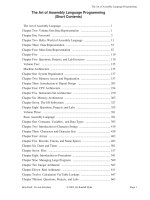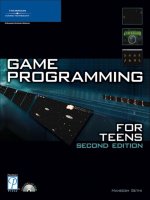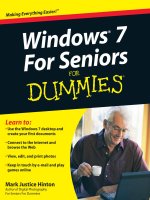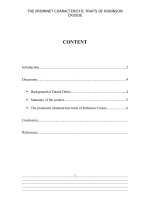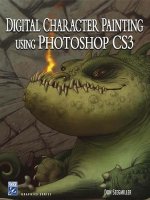Tài liệu The Extreme Searcher`s Internet Hanbook P1 docx
Bạn đang xem bản rút gọn của tài liệu. Xem và tải ngay bản đầy đủ của tài liệu tại đây (572.69 KB, 30 trang )
i
This page intentionally left blank
A Guide for the Serious Searcher
Randolph Hock
Foreword by Gary Price
Medford, New Jersey
iii
The Extreme Searcher’s Internet Handbook:
A Guide for the Serious Searcher
Copyright © 2004 by Randolph E. Hock.
All rights reserved. No part of this book may be reproduced in any form or by any elec-
tronic or mechanical means including information storage and retrieval systems without
permission in writing from the publisher, except by a reviewer, who may quote brief pas-
sages in a review. Published by CyberAge Books, an imprint of Information Today, Inc.,
143 Old Marlton Pike, Medford, New Jersey 08055.
Publisher’s Note: The author and publisher have taken care in preparation of this book
but make no expressed or implied warranty of any kind and assume no responsibil-
ity for errors or omissions. No liability is assumed for incidental or consequential
damages in connection with or arising out of the use of the information or programs con-
tained herein.
Many of the designations used by manufacturers and sellers to distinguish their products
are claimed as trademarks. Where those designations appear in this book and Information
Today, Inc. was aware of a trademark claim, the designations have been printed with ini-
tial capital letters.
Library of Congress Cataloging-in-Publication Data
Hock, Randolph, 1944-
The extreme searcher’s Internet handbook : a guide for the serious searcher /
Randolph Hock ; foreword by Gary Price.
p. cm.
Includes index.
ISBN 0-910965-68-4 (pbk.)
1. Internet searching Handbooks, manuals, etc. 2. Web search engines Hand-
books, manuals, etc. 3. Computer network resources Handbooks, manuals, etc. 4.
Web sites Directories. 5. Internet addresses Directories. I. Title.
ZA4230.H63 2004
025.04 dc22
2003020596
Printed and bound in the United States of America.
Publisher: Thomas H. Hogan, Sr.
Editor-in-Chief: John B. Bryans
Managing Editor: Deborah R. Poulson
Copy Editor: Dorothy Pike
Graphics Department Director: M. Heide Dengler
Book Design: Erica Pannella
Cover Design: Jacqueline Walter
Indexer: Nancy Kopper
iv
v
D EDICATION
To Pamela, Matthew, Stephen, and Elizabeth
This page intentionally left blank
List of Illustrations and Tables xi
Foreword, by Gary Price xv
Acknowledgments xvii
Introduction xix
About The Extreme Searcher’s Web Page xxv
Chapter 1
Basics for the Serious Searcher 1
The Pieces of the Internet 1
A Very Brief History 2
Searching the Internet: Web “Finding Tools” 6
General Strategies 10
A Basic Collection of Strategies 12
Content on the Internet 14
Content—The Invisible Web 19
Copyright 22
Citing Internet Resources 23
Keeping Up-to-Date on Internet Resources and Tools 24
Chapter 2
General Web Directories
and Portals
25
Strengths and Weaknesses of General Web Directories 25
Selectivity of General Web Directories 26
Classification of Sites in General Web Directories 26
Searchability of General Web Directories 27
Size of Web Directory Databases 27
Search Functionality in Web Directory Databases 27
When to Use a General Web Directory 27
The Major General Web Directories 28
Other General Directories 39
General Web Portals 40
Summary 45
vii
C ONTENTS
T ABLE OF C ONTENTS
viii
T
HE
E
XTREME
S
EARCHER
’
S
I
NTERNET
H
ANDBOOK
Chapter 3
Specialized Directories 47
Strengths and Weaknesses vs. Other Kinds of Finding Tools 47
How to Find Specialized Directories 47
What to Look for in Specialized Directories and How They Differ 50
Some Prominent Examples of Specialized Directories 51
Chapter 4
Search Engines 61
How Search Engines Are Put Together 61
How Search Options Are Presented 62
Typical Search Options 63
Search Engine Overlap 69
Results Pages 69
Profiles of Search Engines 70
AllTheWeb 70
AltaVista 78
Google 86
HotBot 99
Teoma 104
Other General Web Search Engines 108
Specialty Search Engines 110
Metasearch Engines 110
Keeping Up-to-Date on Web Search Engines 111
Chapter 5
Groups and Mailing Lists 115
What They Are and Why They Are Useful 115
Groups 116
Using Google to Find Groups and Messages 119
Yahoo! Groups 123
Other Sources of Groups 127
Mailing Lists 128
One More Category—Online Instant Messaging 131
Some Netiquette Points Relating to Internet
Groups and Mailing Lists 132
Chapter 6
An Internet Reference Shelf 133
Thinking of the Internet as a Reference Collection 133
Some Sites All Researchers Should Know About 134
Encyclopedias 135
Dictionaries 137
Almanacs 138
Addresses and Phone Numbers 139
Quotations 140
Foreign Exchange Rates/Currency Converter 142
Weather 143
Maps 143
Gazetteer 143
ZIP Codes 144
Stock Quotes 144
Statistics 144
Books 146
Historical Documents 151
Governments and Country Guides 151
U.S. Government 152
U.S. State Information 153
U.K. Government Information 153
Basic Resources for Company Information 153
Associations 156
Professional Directories 157
Literature Databases 158
Colleges and Universities 159
Travel 159
Film 161
Reference Resource Guides 161
Chapter 7
Sights and Sounds:
Finding Images, Audio, and Video
163
The Copyright Issue 163
Images 164
Audio and Video 175
Chapter 8
News Resources 181
Types of News Sites on the Internet 181
Finding News—A General Strategy 182
News Resource Guides 183
Major News Networks and Newswires 185
ix
C
ONTENTS
Newspapers 187
Radio and TV 188
Aggregation Sites 189
Specialized News Services 195
Alerting Services 196
Chapter 9
Finding Products Online 199
Categories of Shopping Sites on the Internet 199
Looking for Products—A General Strategy 200
Company Catalogs 200
Shopping Malls 202
Price Comparison Sites 205
Product and Merchant Evaluations 206
Buying Safely 208
Chapter 10
Becoming Part of the Internet:
Publishing
211
What’s Needed 212
Sites to Help You Build Your Web Sites 217
Alternatives to Your Own Web Site 219
Conclusion 221
Glossary 223
URL List 231
About the Author 249
Index 251
x
T
HE
E
XTREME
S
EARCHER
’
S
I
NTERNET
H
ANDBOOK
FIGURE 1.1
Yahoo!’s Main Directory Page 8
FIGURE 1.2
Web Search Engine—AllTheWeb’s Advanced
Search Page
9
FIGURE 1.3
Ranked Output 12
FIGURE 1.4
Wayback Machine Search Result Showing Pages
Available in the Internet Archive for whitehouse.gov 19
FIGURE 2.1
Yahoo! Directory Page 29
FIGURE. 2.2
Yahoo! Search Results Page 32
FIGURE 2.3
Open Directory Directory Page 33
FIGURE 2.4
Open Directory Search Results Page 35
FIGURE 2.5
LookSmart Home Page 38
FIGURE 2.6
LookSmart Search Results Page 38
FIGURE 2.7
My Yahoo! Personalized Portal Page 43
FIGURE 3.1
Resources Section of a Teoma Results Page
(a Search on “Solar Energy”) 48
FIGURE 3.2
E
EVL: The Internet Guide to Engineering,
Mathematics, and Computing 55
FIGURE 3.3
New York Times Cybertimes—Business,
Financial, and Investing Resources 56
FIGURE 3.4
Kidon Media Link 60
FIGURE 4.1
Example of the Menu Approach to Qualifying
a Search Term 63
FIGURE 4.2
Example of Using a Prefix to Qualify a Term 63
FIGURE 4.3
Boolean Operators (Connectors) 67
FIGURE 4.4
Menu Form of Boolean Choices 68
FIGURE 4.5
Example of Boolean Syntax 68
TABLE 4.1
Search Engines’ Boolean Syntax 69
FIGURE 4.6
AllTheWeb Home Page 71
xi
LIST OF ILLUSTRATIONS AND TABLES
FIGURE 4.7
AllTheWeb Advanced Search Page 72
FIGURE 4.8
AllTheWeb Results Page 76
FIGURE 4.9
AltaVista Home Page 79
FIGURE 4.10
AltaVista’s Advanced Search Page 81
FIGURE 4.11
Google’s Home Page 87
FIGURE 4.12
Google’s Advanced Search Page 89
FIGURE 4.13
Google Results Page 94
FIGURE 4.14
Google Toolbar 98
FIGURE 4.15
HotBot Home Page 99
FIGURE 4.16
HotBot’s Advanced Page 102
FIGURE 4.17
Teoma’s Home Page 104
FIGURE 4.18
Teoma’s Advanced Page 106
TABLE 4.2
Search Engines Features Chart 112
FIGURE 5.1
Google Groups: Browsing Within a Hierarchy 120
FIGURE 5.2
Google’s Advanced Groups Search Page 121
FIGURE 5.3
Google Groups: Message Thread 122
FIGURE 5.4
Yahoo! Group Description Page 125
FIGURE 5.5
List of Yahoo! Group Messages 126
FIGURE 5.6
Topica List Description 131
FIGURE 6.1
Article from Encyclopedia.com 136
FIGURE 6.2
Definition from Merriam-Webster Online 138
FIGURE 6.3
Bartleby.com 142
FIGURE 6.4
USA Statistics in Brief 147
FIGURE 6.5
The Online Books Page 150
FIGURE 6.6
Hoovers 156
FIGURE 7.1
Google’s Advanced Image Search Page 169
FIGURE 7.2
AltaVista’s Image Search Page 171
FIGURE 7.3
AllTheWeb’s Advanced Pictures Search Page 172
FIGURE 8.1
Kidon Media-Link 184
FIGURE 8.2
BBC News Advanced Search Page 186
TABLE 8.1
Search Engine News Search Features 190
FIGURE 8.3
World News Network 191
FIGURE 8.4
AllTheWeb Advanced News Search Page 192
FIGURE 8.5
AltaVista News Search 193
xii
T
HE
E
XTREME
S
EARCHER
’
S
I
NTERNET
H
ANDBOOK
FIGURE 8.6
Google News Search 194
FIGURE 8.7
NewsAlert Topic Construction 197
FIGURE 9.1
ThomasRegister Category Listing 201
FIGURE 9.2
Yahoo! Shopping Page 203
FIGURE 9.3
Froogle Results Page 205
FIGURE 10.1
Dreamweaver 214
FIGURE 10.2
Example of a Geocities Template 217
FIGURE 10.3
Webmonkey Beginners Page. 218
xiii
L
IST OF
I
LLUSTRATIONS AND
T
ABLES
This page intentionally left blank
Many people believe that searching the Web is as easy as typing a few
terms into a box and clicking the search button. Like magic, in a matter of
seconds, links to precise, accurate, and current answers will appear.
Unfortunately, this is not the case.
The term “search” is very broad and means different things to different
people. For some people it means using an engine like AllTheWeb or Teoma.
For others it includes the use of a Web directory focused on a specific topic.
For some, search means utilizing not only Web engines but also specialized
databases that may contain geographic data, full-text articles, or government
information.
Another major issue for the searcher is where to begin. Questions revolve
around what each resource does and does not offer. Which is most likely to
hold the information I need? How often is the database updated? Can I limit
my search to a particular format? Can I change the number of results I see on
a results page? What advanced features are available? Knowing where to find
this information and then how to apply it can help the Web searcher avoid
coming face-to-face with massive amounts of aggravation and wasted time.
Complicating the situation is that as already large Web engines, directo-
ries, and databases get larger, it is becoming much more challenging to find
what you’re looking for. While the retrieval technology is getting better, to
find information effectively your search skills must not only be up-to-date,
they must be constantly improving.
The good news is that with just a little education and guidance, searching,
retrieving, and accessing material on the Web can become easier. Having
these skills will make you a better student. Knowing how to save search time
will make you a more valuable employee.
These are a few of the reasons why the knowledge, experience, and opin-
ions of Internet search expert Ran Hock are so valuable. This latest book of
xv
F OREWORD
Ran’s, The Extreme Searcher’s Internet Handbook, is a resource you’ll find
yourself referring to on a regular basis.
These days, people tend to rely on a single search tool for all of their
Internet research needs. As Ran vividly illustrates, effective searching
requires that you know how to use a number of tools. He does a great job of
covering the wide range of resources available to the Web searcher. From
news engines to quotation databases, specialized directories to online refer-
ence works, groups and mailing lists to image and audio finding tools, com-
parison shopping sites, portals, and more, Ran provides not only the
addresses of these sources but the reasons you might want to use them. He
also addresses copyright and citation issues, among other important topics
for Web searchers.
Ran Hock has done more than write a book. He’s created a key resource
for both those who need a bit of education in the area of Web research and
for experienced searchers who need to verify what a specific search tool
offers.
I don’t doubt that in a very short period of time your copy will be dog-
eared, full of notes, draped with Post-Its, and nothing short of worn out.
Maybe you should buy two copies …
—Gary Price
November, 2003
Gary Price is a reference librarian and information consultant based in suburban Washington, DC.
He is co-author of The Invisible Web: Uncovering Information Sources Search Engines Can’t See and
edits ResourceShelf (), a daily update on Web search and other online
retrieval news.
xvi
T
HE
E
XTREME
S
EARCHER
’
S
I
NTERNET
H
ANDBOOK
First, the great group of people at Information Today, Inc. are due my sin-
cere thanks for their hard work, creativity, and enthusiasm in getting this
book to press and into readers’ hands. In particular, I am grateful to Tom
Hogan, Sr. for the existence of Information Today, Inc., to John Bryans for
his encouragement and support and for agreeing to do this book, to Deborah
Poulson for shepherding it through the process, to Dorothy Pike for a great
job of copyediting, to Heide Dengler for her role on the graphics side of
things, and to Erica Panella, Kara Jalkowski, and Jacqueline Walter, the cre-
ative artists and designers who gave the book its unique look. Special thanks
to Lisa Wrigley not just for her tireless efforts in promoting my books, but
also for her unabated enthusiasm for them.
Once again, my appreciation to my friends in the New England Online
Users Group for having suggested the phrase “Extreme Searcher” to me sev-
eral years ago.
Thanks also to the readers of my earlier books for their support, encour-
agement, and comments. I also offer my gratitude to the many hundreds of
students in the courses I teach, for their insights and comments on using the
Internet effectively and on what excites them most about the wonders of the
Internet.
xvii
A C KNOWLEDGMENTS
This page intentionally left blank
Several years ago, Thomas’s English Muffins had an ad that proclaimed
that the tastiness of their muffins was due to the presence of myriad “nooks
and crannies.” The same may be said of the Internet. It is in the Internet’s nooks
and crannies that the true “tastiness” often lies. Almost every Internet user has
used Google and probably Yahoo!, and any group of experienced searchers
could probably come up with a dozen or so sites that every one of them had
used. But even for experienced searchers, time and task constraints have meant
that some nooks and crannies have not been explored and exploited. These
unexplored areas may be broad Internet resources such as newsgroups, specific
types of resources such as multimedia, or the nooks and crannies of a specific
site—even Google. This book is intended to be an aid in that exploration.
Back on the culinary scene, I am told that some people don’t take the few
extra seconds to split their English muffins with a fork, but, driven by their busy
schedules, just grab a knife and slice them. This book is written for those
seeking to savor the extra tastiness from the Internet. It will hopefully tempt
you to discover what the nooks and crannies have to offer, and how to split the
Internet muffin with a fork almost as quickly as you can slice it with a knife.
Less metaphorically, this book is written as a guide for researchers, writers,
librarians, teachers, and others, covering what serious users need to know to
fully take advantage of Internet tools and resources. It focuses on what the
serious searcher “has to know” but, for flavor, a dash of the “nice-to-know” is
occasionally thrown in. It assumes that you already know the basics, that you
are signed up for and frequently use the Internet, and that you know how to
use your browser. For those who are not experienced online searchers, my
aim is to provide a lot that is new and useful. For those of you with more
experience, I hope to reinforce what you know while introducing some new
perspectives and new content.
xix
I NTRODUCTION
If you are among those who find themselves not just using the Internet, but
teaching it, the book should help you address an extensive range of questions.
Much of what is included is based on my experience training thousands of
Internet users from a wide range of professions, across a broad age range, and
from more than 40 countries.
B
RIEF
O
VERVIEW OF THE
C
HAPTERS
The choice of chapter topics reflects congruence between the types of things
that experienced Internet users most frequently inquire about and a categorization
of the kinds of resources available on the Internet. An argument could certainly be
made that the content should have been divided differently. You will notice, for
example, that there is a chapter on Finding Products, and you may wonder why
there is not one specifically on “company information.” This is because the lat-
ter topic pervades almost every chapter. Not every chapter will be of utmost inter-
est to every reader, but give each chapter at least a quick glimpse. You may be
surprised at what is in some of the nooks (and crannies, of course).
Although the nature of each chapter means that it has an organization of its
own, they all contain some things in common. Typically, each chapter includes
these aspects:
• Some useful background information, along with suggestions, tips,
and strategies for finding and making the most effective use of sites in
that area.
• Resource guides that will lead you to collections of links to major
sites on the topic.
• Selected sites. I’ve selected these because (1) they are sites that many
if not most readers should be aware of, and/or (2) they are
representative of types of sites that are useful for the topic. Deciding
which sites to include was often difficult. Many of the sites included in
this book are considered to be “the best” in their area, but space
limitation means that hundreds of great sites had to be excluded. These
difficult decisions were made more palatable, however, because the
resource guides included in the chapters will lead you quickly to those
great sites—you’re only one or two clicks away.
Following is a quick rundown of what each chapter covers.
xx
T
HE
E
XTREME
S
EARCHER
’
S
I
NTERNET
H
ANDBOOK
Chapter 1. Basics for the Serious Searcher
This chapter covers background information that serious searchers need to
know in order to be conversant with Internet content and issues. It includes
some background for understanding more fully the characteristics, content,
and searchability of the Internet. For those who find themselves teaching others
how to use the Internet, it provides answers to some of the more frequently
asked questions. Among the things included in Chapter 1 are a brief history
of the Internet, a look at the kinds of “finding tools” available, issues such as
retrospective coverage and copyright, resources regarding citing Internet
sources, and others for keeping up-to-date.
Chapter 2. General Web Directories and
Portals
Although they have quite a bit in common with Web search engines, gen-
eral Web directories such as Yahoo!, Open Directory, and LookSmart also
differ tremendously. This chapter addresses where these tools fit and when
they may be most fruitfully used. Even though their databases may include
less than 1 percent of what search engine databases cover, general Web
directories still serve unique research purposes and in many cases may be
the best starting point. This chapter looks at their strengths, their weak-
nesses, and their special characteristics. Since these general directories are
positioned to varying degrees as “portals,” this chapter also addresses the
“portal” concept.
Chapter 3. Specialized Directories
For accessing immediate expertise in Web resources on a specific topic,
there is no better starting point than the right “specialized directory.” These
sites bring together well-organized collections of Internet resources on specific
topics and provide not just a good starting place, but also—importantly—con-
fidence in knowing that no important tools in that area are being missed. Add
some content such as news headlines, and you have not just a metasite but a
“portal,” making these tools even more important as starting points.
xxi
I
NTRODUCTION
Chapter 4. Search Engines
This chapter attempts to provide the background and details about search
engines that the serious searcher needs to know in order to get the best results.
It examines the largest engines in detail, identifying their strengths and weak-
nesses and special features. It also presents the case for not getting too excited
about metasearch engines.
Chapter 5. Groups and Mailing Lists
Newsgroups, mailing lists, and other interactive forums form a class of Inter-
net resource that too few researchers take advantage of. Useful for a broad range
of applications, from solving a software problem to competitive intelligence, these
tools can be gold mines. This chapter outlines what they are, why they are useful,
and how to locate the ones you need.
Chapter 6. An Internet Reference Shelf
All serious searchers have a collection of tools they use for quick answers—
the Web equivalent of a personal reference shelf. This chapter emphasizes
the variety of resources that are available for finding quick facts, offers some
direction on how to find the right site for a specific need, and suggests several
dozen sites that most serious searchers should be aware of.
Chapter 7. Sights and Sounds:
Finding Images, Audio,
and Video
Not only are there a half billion or so images, audio files, and video files avail-
able on the Web, but they are searchable (even better, findable). Whether you are
looking for photos of world leaders or rare birds, a famous speech, or the sound of
an elephant seal, this chapter provides a look at what resources and tools are avail-
able for finding the needed file and discusses techniques for doing so effectively.
Chapter 8. News Resources
This chapter covers the range of news resources that are available on the
Internet—news services and newswires, newspapers, news consolidation services,
and more—and explains how to most effectively and efficiently find what you
are looking for. The chapter emphasizes, on one hand, the searchability of these
xxii
T
HE
E
XTREME
S
EARCHER
’
S
I
NTERNET
H
ANDBOOK
resources, and on the other, the limitations the researcher faces, particularly
in regard to archival and exhaustivity issues.
Chapter 9. Finding Products Online
Whether for one’s own or one’s organization’s purchase, or for competitive
analysis purposes, some searchers find themselves tracking and comparing
products online. This chapter shows where to look and how to do it efficiently
and effectively.
Chapter 10. Becoming Part of the Internet:
Publishing
Beyond using the Internet to gather information, many serious searchers
need to have a Web site of their own. Reasons may range from communicating
information about the services or products one may provide, to sharing resources
with colleagues, to providing a syllabus and links for classes you may be teaching.
Although this chapter does not provide the details of how to become a Webmaster,
it does offer an overview of what is needed and the options that are available
to those who want to move in that direction—including how to get started at
no cost by taking advantage of free Web page sites.
S
OME
I
NTRODUCTORY
O
DDS AND
E
NDS
Most of the sites I discuss in the book do not charge for access. Occasionally,
reference is made to sites that require a paid subscription or offer information
for a fee, in part as a reminder that (as the serious searcher is already aware) not
all of the good stuff is available for free on the Internet. Commercial services
such as Lexis/Nexis, Factiva, and Dialog contain proprietary information that is
critical for many kinds of research and is not available on the free Web.
Sites are included here because they have useful content. Except for associ-
ation, government, and academic sites, most of the sites mentioned are sup-
ported by ads. On the Internet, just as with television and radio, if the ratio of
advertisements to useful content is too high, we can switch to another channel
and another Web site. Some of us have come to appreciate the ads to some extent,
aware as we are that advertising makes many valuable sites possible.
xxiii
I
NTRODUCTION
A Word on “Usage”
Although “Internet” and “Web” are not synonymous, most users do not dis-
tinguish between them. When it makes a difference, I use the appropriate term.
Where I refer to resources that are generally on the Web part of the Internet, “Web”
is used. Where the terms are interchangeable, either term may be used.
Some Final Basic Advice
Before You Proceed
Most of us, as we have encountered the Internet over the last decade or so,
have learned much of what we know about it in a rather piecemeal fashion, for
instance, having been told about a great site, having bumped into it, or having read
about it. Although this is, in many ways, an effective approach to exploring the
Internet, it can leave gaps in our knowledge. Because each user has individual needs,
no single book can fill all of the gaps, but this one attempts to help by pro-
viding a better understanding of what is out there as well as some starting
points and suggestions for getting what you need—to help you find your way
to the most useful nooks and crannies.
As you explore, keep in mind the following three guidelines to help you get
the most value from the Internet:
One—“Click everywhere.”
Two—“Click where you have never clicked before.”
Three—“Split your muffins with a fork.”
xxiv
T
HE
E
XTREME
S
EARCHER
’
S
I
NTERNET
H
ANDBOOK



